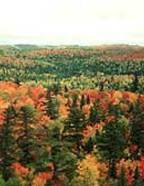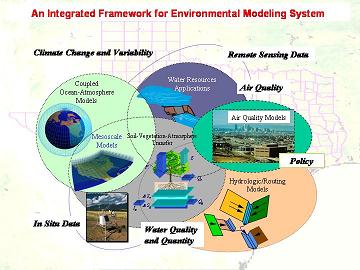|
|

Project Funding: $750,000
Funding Period: 11/1/03-10/31/07 Principal Investigator: Dr. Zong-Liang Yang Co-Investigators: David T. Allen (Chemical Engineering) Barbara Parmenter (Architecture) Also See: U.S. Environmental Protection Agency (EPA) National Center for Environmental Research (NCER) Science to Achieve Results (STAR) Biosphere-atmosphere Exchange of Aerosols within Cloud, Carbon and Hydrologic cycles, including Organics & Nitrogen (BEACHON) Impacts of Climate Change and Land Cover Change on Biogenic Volatile Organic Compounds (BVOCs) Emissions in Texas (RD83145201)Objectives:
Purpose of the Study: Significant amounts of vegetation and forests in eastern and central Texas are the source of substantial emissions of volatile organic compounds (VOCs), which, when mixed with nitrogen oxides (NOx) from anthropogenic sources (automobiles, electrical power generation, industrial boilers, incinerators and jet engines), can form tropospheric ozone - an air pollutant and a greenhouse gas. These biogenically-emitted VOCs (hereafter BVOCs) include isoprene (C5H8), monoterpenes (C10H16), and other reactive carbon compounds. Through their effects on atmospheric chemistry, aerosol concentrations, and the global carbon cycle, BVOC emissions can also potentially influence global climate. The biogenic emissions depend on many factors, primarily the types of vegetation species, as well as the densities of these species. Isoprene is the most abundant of BVOCs, and is emitted by oak, sweetgum, eucalyptus, and aspen. Monoterpenes are the second most abundant of BVOCs, and are emitted by pine, cypress, spruce and fir. In addition, BVOC emissions vary with environmental conditions such as temperature, light (solar radiation), plant water stress, and ambient ozone and CO2 concentrations. At present, the response of BVOC emissions to climate change and land cover change is largely unknown. 
We propose to address this issue by applying an integrated land-emission-climate modeling system (see below) to assess the effects of climate change and land cover change on BVOC emissions at the regional scale in Texas. Hypothesis: We hypothesize that climate change influences the emissions of biogenic volatile organic compounds (BVOCs) and hence air quality both directly and indirectly. The direct effect is that the changes in the surface incident solar radiation and air temperature, among other variables, affect the vegetation’s capability to release BVOCs. The indirect effect is that the climate change will cause changes in the types of vegetation species as well as the prevalence of these species, thereby modulating the emission rates of BVOCs. In addition, human-driven land use change will also impact BVOC emissions. Approach: The study area focuses on the State of Texas for three main reasons:
We will integrate the Community Land Model (CLM3), which includes a dynamic general vegetation model (DGVM), with a biogenic emission module (BEIS/GLOBEIS) to explicitly estimate BVOC emissions. The CLM3 simulates, at every time step, the exchange of water, carbon, energy, and momentum between the land surface and atmosphere through a wide range of ground and canopy bio-geophysical processes which BVOC emissions depend on. A newly mapped land use dataset with a spatial resolution of 1 km and over 600 classifications for the state of Texas, together with human-driven land use change in urban areas (Houston/Galveston, Dallas/Ft. Worth, San Antonio, and Austin), will be used to estimate BVOC emissions. The DGVM will not only simulate the interactive vegetation processes (e.g., interaction between leaf growth and precipitation) but also include vegetation competition and distribution and dynamic disturbance (typically fire). The CLM3-DGVM with the biogenic emission module will be linked first to the NCEP re-analysis data for an “off-line” sensitivity study and then to a regional climate model (WRF) for an investigation of system “feedbacks” and future climate sensitivities. Particular care will be taken to separate the effects of human-induced land use change. Publications and Presentations: (* denotes the student first author)
Project Progress Reports: |